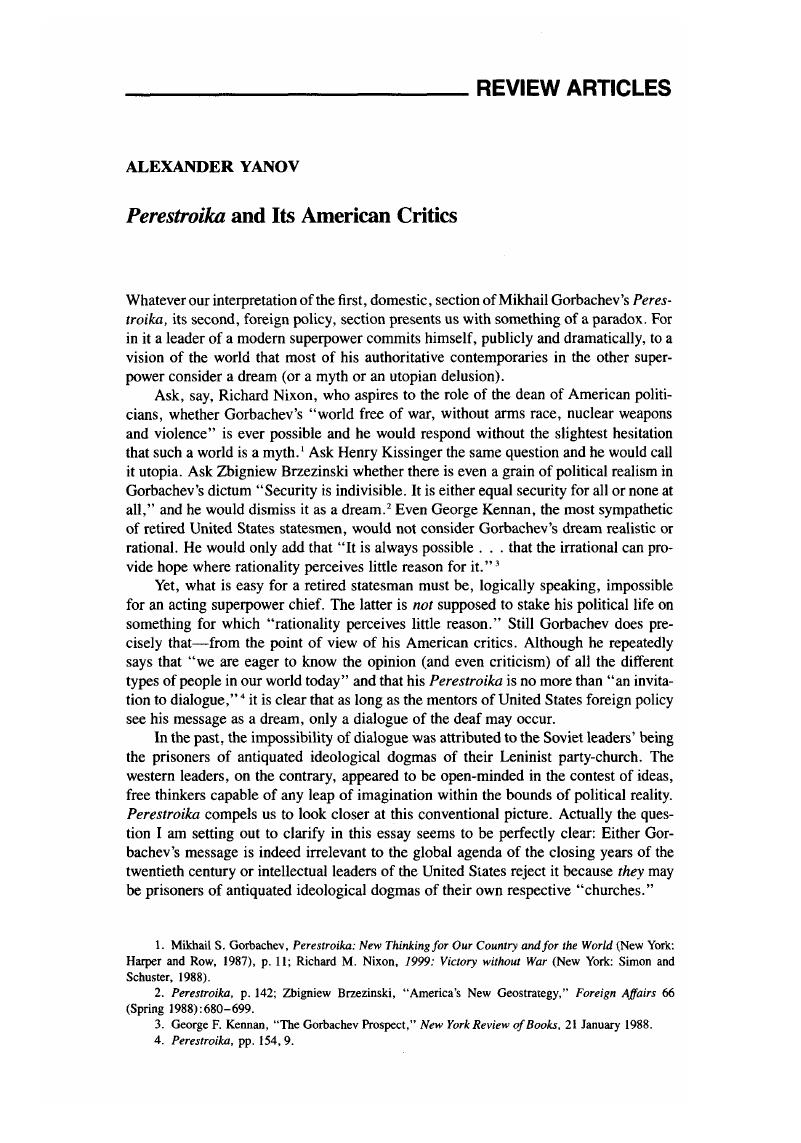No CrossRef data available.
Article contents
Perestroika and Its American Critics
Published online by Cambridge University Press: 27 January 2017
Abstract

- Type
- Review Articles
- Information
- Copyright
- Copyright © Association for Slavic, East European, and Eurasian Studies. 1988
References
1. Gorbachev, Mikhail S., Perestroika: New Thinking for Our Country and for the World (New York: Harper and Row, 1987, p. 11 Google Scholar; Nixon, Richard M., 1999: Victory without War (New York: Simon andSchuster, 1988 Google Scholar.
2. Perestroika, p. 142; Zbigniew Brzezinski, “America's New Geostrategy,” Foreign Affairs 66 (Spring 1988): 680–699.
3. George F. Kennan, “The Gorbachev Prospect,” New York Review of Books, 21 January 1988.
4. Perestroika, pp. 154, 9.
5. Ibid., p. 146.
6. Ibid., pp. 146–147, 138.
7. Ibid., p. 141.
8. Hans J. Morgenthau, Politics among Nations (New York: Knopf, 1985), p. 37.
9. Perestroika, p. 141.
10. Ibid., p. 12.
11. Ibid., p. 142.
12. Ibid., pp. 140, 13.
13. Ibid., p. 136.
14. Ibid., pp. 144, 147, 148.
15. Ibid., p. 140.
16. Ibid., p. 145.
17. The closest Soviet reform ideologists ever came to such a distinction is Fedor Burlatskii's “Kakoisocializm narodu nuzhen?” Literaturnaia Gazeta, 20 April 1988.
18. See, for example, Nina Andreeva, “Ne mogu postupitsa printsipami,” Sovetskaia Rossia, 13March 1988.
19. Brian Crozier, “Gorbachev's Dilemma,” National Review, 19 February 1988.
20. “Mikhail Gorbachev's Perestroika: A Call for Universal Restructuring
21. Crozier, “Gorbachev's Dilemma,” pp. 52, 54.
22. Brzezinski, “America's New Geostrategy,” p. 694.
23. Ibid., p. 687.
24. Ibid., p. 695.
25. Richard M. Nixon, “Dealing with Gorbachev,” New York Times Magazine, 13 March 1988, p. 30.
26. Ibid., p. 79.
27. Perestroika, p. 138.
28. “Dealing with Gorbachev,” p. 79.
29. Ibid.; emphasis added.
30. Perestroika, p. 21.
31. Kennan, “The Gorbachev Prospect. “
32. Perestroika, p. 24.
33. For details, see Alexander Yanov, The Drama of the Soviet 1960s: A Lost Reform (Berkeley: Instituteof International Studies, 1984).
34. “Mikhail Gorbachev's Manifesto,” Washington Post Book World.
35. New York Times, 23 November 1987.
36. Dave McCurdy, “Dukakis, Jackson: Too Far Left,” New York Times 3 May 1988.


